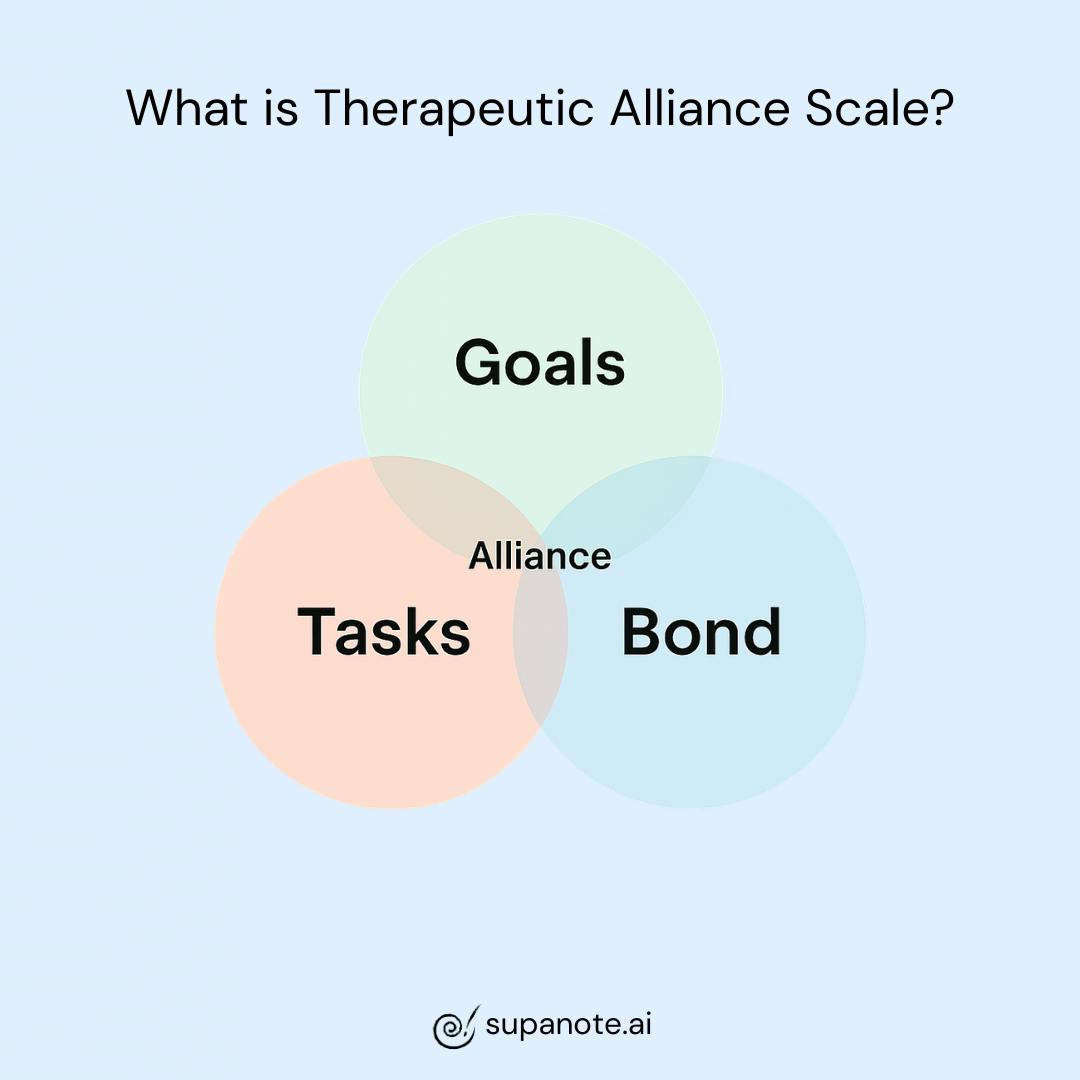You’re in session. You’re using all the right tools. But something feels off.
The client is holding back. You’re doing your part but the connection isn’t there.
The reason? It might not be the method. It’s the therapeutic alliance.
In this blog, we’ll talk about what therapeutic alliance really is, why it matters in every session, and how to build it - without burnout or extra stress.
We'll also look at what current psychotherapy research says and how it can lead to better psychotherapy outcomes and positive outcomes for both clients and therapists.
Plus, we'll explore major tools like the Working Alliance Inventory, California Psychotherapy Alliance Scales, and other alliance structure assessment tools that help therapists improve outcomes across clinical settings.
What is the Therapeutic Alliance?
The therapeutic alliance is the working relationship between you and your client.
It’s not just being friendly- it’s about teamwork, mutual trust, and a shared mission.

It includes:
Key Elements | What it Means |
|---|---|
Goals | You both agree on what therapy is trying to achieve |
Tasks | You both agree on the specific tasks to get there |
Bond | There’s emotional trust, mutual affirmation, and care |
This isn't a one-time check-in. The alliance structure develops across sessions and can change depending on the therapeutic process. Different perspectives, including the therapist's and the patient's perceptions, shape how this bond forms.
Therapists can use tools like the Working Alliance Inventory, Kim Alliance Scale, or the California Psychotherapy Alliance Scales to measure the strength of their working alliance with clients. These self-report and observer-rated scales also support convergent validity and inter-rater reliability in research and supervision.
One of the main aspects that makes the therapeutic alliance effective is its emotional depth.
This includes unconditional positive regard, active listening, and emotional attunement- all of which are supported by research into the psychotherapeutic process.
What the Therapeutic Alliance Is Not?
A quick reality check - the alliance isn’t just about “vibing” with your client.
A lot of therapists (and clients) mistake it for being friendly or having good chemistry. But that’s not what makes an alliance therapeutic.
Here’s what it’s not:
- It’s not friendship
You’re not their buddy. You are a consistent, safe presence with a shared goal. - It’s not a constant agreement
Great therapy can involve healthy disagreement. In fact, collaborative tension can deepen trust- if it's handled with care. - It’s not avoiding tough conversations
Ruptures are part of the process. Ignoring them doesn’t preserve the alliance - it weakens it. - It’s not fake warmth
Clients can tell when it’s performative. The alliance grows from genuine attunement, not perfectly rehearsed empathy. - It’s not a one-and-done thing
The alliance isn’t built in one session and then set forever. It evolves. It flexes with the work.
So, while being warm and supportive helps, the therapeutic alliance is ultimately about trust, collaboration, and a shared commitment to the work- not just being “nice.”
Why It Matters in Therapy
Therapists often ask: What predicts successful therapy? Is it technique, training, or modality?
Research and meta-analyses show the answer: the strength of the therapeutic alliance.
When the alliance is strong:
- Clients open up and show active participation
- Sessions feel more collaborative
- Treatment success is more likely
- Therapists feel less burned out in clinical settings
The alliance in psychotherapy has a significant correlation with therapy outcomes - even across different perspectives, from clients to independent raters.
It is a key factor in achieving goals within a treatment plan, especially when aligned with mutual trust and affective aspects of the therapeutic relationship.
"You are the most important tool in the room." — a common belief in mental health care.
The alliance includes affective aspects like empathic resonance, mutual trust, and a supportive attitude.
Even the patient's perception of the therapist influences outcomes. That’s why the alliance construct is considered a central factor in psychotherapy research today.
There's a growing interest in the role of therapeutic bond scales as well - tools that allow clinicians to assess the quality and depth of the emotional connection, which is often one of the most overlooked but essential ingredients for therapy to work.
How to Build a Strong Therapeutic Relationship (Step-by-Step)
1. Start With Connection
- In the first session, focus on building a personal bond.
- Ask simple questions. Listen fully.
- Reflect their words. This builds mutual influence and sets up a collaborative relationship.
2. Talk About the Therapy Process
- Let them know that their voice matters in the treatment plan.
- Say: “If something feels off, we can talk about it.”
- Highlight the importance of active participation and specific tasks throughout therapy.
3. Repair When Needed
- Notice ruptures: skipped sessions, changes in tone, avoidance.
- Say: “You seemed quieter today—should we explore that?”
Therapists who recognise and address ruptures early see more consistent progress.
4. Stay Present
- Note-taking during sessions can break the flow.
- Use a tool like Supanote after the session to help document your notes and protect your connection.
Some therapists use the Vanderbilt Psychotherapy Process Scale or Agnew Relationship Measure to track alliance over time. These tools help reveal the key elements in the alliance structure assessed over multiple sessions.
5. Reflect and Adjust
- Ask for feedback: "Is this working for you?"
- Adapt based on your client’s feedback. This shows respect for the personal relationship you’re building.
There are several factors that shape this process: your therapeutic orientation, your ability to stay emotionally available, and your ongoing willingness to engage in reflective practice. Each one contributes to how the therapeutic alliance functions session after session.
Real-Life Example: The Teen Who Wouldn’t Talk
A 16-year-old was sent to therapy by a school counsellor. He didn’t want to be there. He barely spoke.
The therapist focused on actively listening, not analysing. They talked about music and games. They built a strong therapeutic bond before asking about emotions.
After a few weeks, the teen opened up. The alliance construct had formed naturally.
Lesson: You can’t get to insight before trust. This is a clear case of how a strong therapeutic alliance can lead to successful therapy and long-term personal growth.
A possible explanation for this shift? The therapist created a safe space through a steady therapeutic presence and nonjudgmental tone—key elements reflected in strong alliance scores across various tools.
Automating Therapy Notes
Therapists today are busier than ever. With high caseloads, compliance demands, and the emotional energy it takes to be fully present with clients, documentation often becomes overwhelming.
Supanote was built to solve this problem. It’s an AI-powered scribe tool that automatically generates high-quality, audit-ready therapy notes, without interrupting your session flow.
Here’s how Supanote supports the therapeutic alliance:
- Keeps you focused on the client relationship, not your laptop
- Helps you track the therapy process and treatment goals over time
- Captures affective aspects like tone, engagement, and emotional shifts
- Makes it easy to reflect on past sessions and prepare for future ones
You spend less time writing notes and more time building trust.
Whether you're using SOAP, DAP, or custom formats, Supanote adapts to your style and makes the clinical documentation process smoother. It’s the quiet assistant in your corner, helping you protect the alliance while staying compliant.
Want to spend less time on documentation and therapy notes?
Try Supanote for free now and get your evenings back!
Try for Free Now!
Mistakes That Can Weaken an Alliance
- Asking about their past too soon
- Talking more about techniques than their feelings
- Not noticing when they go quiet or pull back
- Looking at the clock while they’re talking
- Saying things that feel a bit judgmental
Tip: Document things like personal growth, therapy process and treatment goals using Supanote after the session.
Some common mistakes also include over-relying on one instrument to assess alliance or failing to consider potential conflict between client needs and therapist approaches.
Exploring multiple tools- such as the Vanderbilt Therapeutic Alliance Scale or Penn Scales can also provide a fuller picture.
How Notes Can Help the Alliance
Notes are not just for audits - they’re part of the therapeutic process.
They help you:
- Track therapy progress
- Reflect clients’ words and tone
- Notice themes across sessions
- Improve psychotherapy outcomes over time
Using self-report measures like the Psychotherapy Status Report or PENN scales can add structure. These tools have high inter-rater reliability and convergent validity.
With Supanote, your documentation includes what actually matters in real therapy-not just checkboxes. It supports a strong therapeutic alliance while saving you time.
Advanced Tools to Measure Alliance
Therapists working in research or high-accountability settings may use structured tools like:
- Working Alliance Inventory
- California Psychotherapy Alliance Scales
- Vanderbilt Therapeutic Alliance Scale
- Agnew Relationship Measure
Each tool focuses on different aspects—bond, agreement, affective aspects, and task alignment. Choosing the right tool depends on your setting, client population, and whether you're assessing from the perspective of the therapist, patient, or an independent rater.
FAQs Therapists Ask
Q: How do I know if my alliance is strong?
A. Use your gut, client feedback, or a validated tool like the Working Alliance Inventory.
Q: Can an alliance be built online?
A. Yes! Even in adult psychotherapy over telehealth, alliance thrives with warmth, pacing, and presence.
Q: Should I document the alliance?
A. Yes. Use language like “Client engaged well; we aligned on treatment plan.” This shows a strong helping alliance.
Q: Can the alliance change?
A. Yes. The alliance structure assessed early may look different over time. Stay flexible.
Q: How can I teach interns about alliance?
A. Start with attachment theory, role-plays, and self-reflection. Use research like recent meta-analyses or studies on the alliance construct.
Q: What if I have financial relationships with third-party providers?
A. Make sure to disclose any commercial or financial relationships. These may affect trust or introduce a potential conflict of interest in some clinical settings.
Resources
- APA Guide on Therapeutic Alliance
- SAMHSA Tips for Engagement
- CE Course on Alliance (PESI)
- NIH: Alliance and Outcomes
- Center for Evidence-Based Mental Health
- Journal of Psychotherapy Integration
- Society for Psychotherapy Research
Try Supanote for free
Automated, HIPAA-compliant Progress Notes so you can focus on your clients
Get Started Now!
